Archived Storm Damage Blog Posts
Winter-Ready Homes: Essential Safety Tips for Pewaukee & Sussex Homeowners | SERVPRO of Pewaukee & Sussex
1/9/2025 (Permalink)
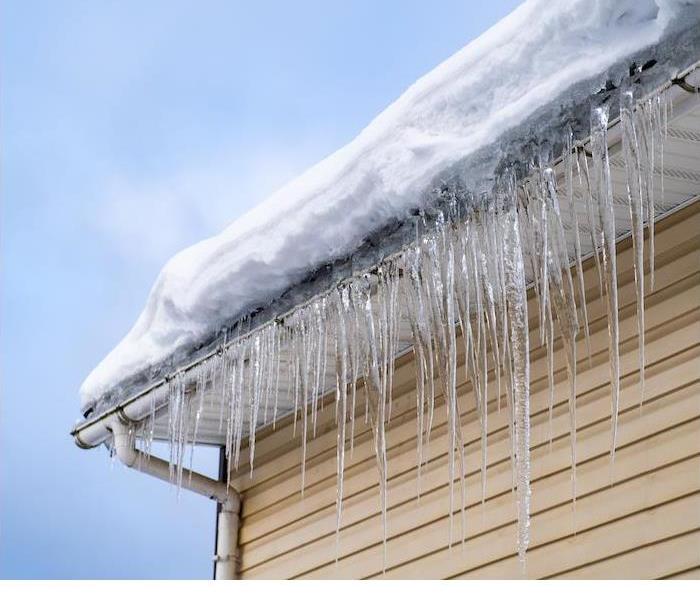 Protect your Pewaukee & Sussex home this winter—SERVPRO is here for all your restoration needs!
Protect your Pewaukee & Sussex home this winter—SERVPRO is here for all your restoration needs!
As winter settles into Pewaukee and Sussex, the colder temperatures, heavy snowfalls, and occasional ice storms can bring a unique set of challenges for homeowners. While these areas just outside Milwaukee are no strangers to winter’s harsh conditions, it’s important to take the necessary precautions to protect your property from the risks associated with the season.
SERVPRO of Pewaukee & Sussex is here to guide you through winter weather safety tips to help keep your home safe and minimize damage during the colder months.
Safeguard Your Pipes Against FreezingIn Pewaukee, Sussex, and the surrounding Milwaukee area, the winter chill can create serious risks for your plumbing. Frozen pipes are one of the most common issues homeowners face during the colder months. When temperatures drop below freezing, water inside your pipes can freeze, causing the pipes to expand and possibly burst, leading to severe water damage. To protect your pipes, be sure to insulate any exposed plumbing in areas like basements, crawl spaces, and attics.
Use foam pipe insulation or heat tape to keep your pipes warm and prevent freezing. During extreme cold, allow faucets to drip slowly to keep the water flowing. Additionally, if you have an irrigation system, drain it before winter arrives. If you experience a frozen or burst pipe, SERVPRO of Pewaukee & Sussex is here to help with emergency water damage restoration.
Prepare Your Roof and Gutters for Snow and IceSnow and ice can wreak havoc on your roof, especially in the winter months. In Pewaukee and Sussex, it’s important to stay ahead of these challenges by maintaining your roof and gutters. Heavy snow and ice buildup can cause leaks, ice dams, and even structural damage if not addressed. Before winter begins, inspect your roof for any missing or damaged shingles, and check the flashing around chimneys, vents, and skylights to make sure water won’t seep in.
It’s also essential to clear your gutters of leaves, twigs, and other debris to prevent water from backing up on the roof. Ice dams, which occur when snow melts and refreezes at the edge of the roof, can cause significant leaks inside your home. If your roof or gutters are damaged during winter storms, SERVPRO of Pewaukee & Sussex is ready to assist with repairs and water damage restoration.
Be Prepared for Winter Power OutagesWinter storms in Pewaukee and Sussex can often lead to power outages, especially when strong winds and heavy snow affect the electrical grid. While power outages are common during winter months, they can be especially challenging when temperatures drop significantly. To prepare for a possible outage, ensure that your home’s heating system is functioning properly and that you have a backup plan for alternative heat sources, such as space heaters.
Make sure to follow all safety guidelines for using space heaters and never leave them unattended. Additionally, stock up on essential supplies such as bottled water, non-perishable food, flashlights, and extra batteries. If your home experiences water damage during a power outage, SERVPRO of Pewaukee & Sussex is available 24⁄7 to help with restoration services and minimize any damage caused by storm-related issues.
Ensure Your Home Is Winter-Ready with SERVPRO of Pewaukee & SussexWinter in Pewaukee and Sussex may bring snowstorms, freezing temperatures, and ice, but with the right preparation, you can protect your home from potential damage. By safeguarding your pipes, inspecting your roof and gutters, and preparing for power outages, you can minimize the risks and ensure that your home is ready for whatever winter has in store.
If you do experience water damage or other winter-related issues, SERVPRO of Pewaukee & Sussex is here to help with fast, professional restoration services. Reach out to us today to keep your home safe and secure this winter season.
What to Do After Storm Damage in Wisconsin: A Guide for Residents | SERVPRO of Pewaukee & Sussex
9/16/2024 (Permalink)
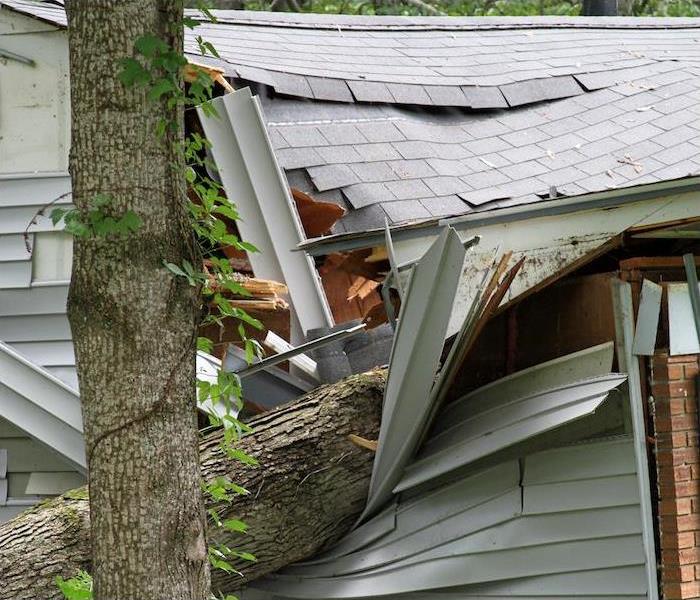 Don't delay! When storm damages affects your property, call SERVPRO of Pewaukee & Sussex to restore your space.
Don't delay! When storm damages affects your property, call SERVPRO of Pewaukee & Sussex to restore your space.
Wisconsin’s weather can be as beautiful as it is unpredictable, especially in the fall when the crisp air and vibrant colors are occasionally interrupted by powerful storms. If your property has suffered storm damage in Pewaukee, Sussex, or the surrounding areas, taking quick and informed action is essential for a successful recovery.
Here’s a guide to help you manage the aftermath and restore your home or business effectively.
Ensure Safety and Assess the DamageThe first step after a storm is to prioritize safety. Begin by inspecting the exterior of your property for any visible damage, such as broken windows, damaged roofing, or fallen trees. Approach this task with caution, as storm-damaged structures can be unstable and dangerous.
Before entering your building, check for potential hazards. Look for signs of gas leaks or electrical issues. If you detect a gas leak or hear unusual sounds, evacuate immediately and contact your gas provider. For electrical concerns, avoid using any appliances and get in touch with a licensed electrician for a thorough inspection.
Once you’re confident that it’s safe to enter, document the damage meticulously. Take clear photographs and detailed notes of both interior and exterior damage. This documentation will be crucial for filing insurance claims and assessing repair needs. Keep a detailed record of all communications with insurance companies and contractors to support your claim and ensure a smooth restoration process.
Contact Your Insurance Provider and Begin the Claims ProcessAfter assessing the damage and ensuring safety, the next critical step is to contact your insurance provider. Report the storm damage as soon as possible and provide them with the documentation you’ve gathered. This will help initiate your insurance claim and ensure you receive the necessary support for repairs.
Your insurance provider will guide you through the claims process, which may include arranging for an adjuster to visit and evaluate the damage. Be prepared to discuss the extent of the damage and any immediate repair needs. Keeping thorough records of all interactions with your insurance company will help support your claim and facilitate a smoother recovery.
While waiting for the insurance adjuster, avoid making permanent repairs until they have assessed the damage. However, you should take temporary measures to prevent further damage, such as covering broken windows with tarps or boarding them up. This helps protect your property from additional issues like water infiltration.
Seek Professional Restoration ServicesWith your insurance claim underway and temporary measures in place, it’s time to engage professional restoration services. At SERVPRO of Pewaukee & Sussex, we specialize in comprehensive storm damage restoration and are equipped to handle all aspects of recovery.
Choosing a reputable restoration company is crucial for a successful recovery. Look for companies with strong credentials, positive customer reviews, and experience working with insurance claims. Our team at SERVPRO of Pewaukee & Sussex has the expertise and advanced equipment necessary to address water damage, mold remediation, and structural repairs effectively.
By partnering with a professional restoration service, you ensure that your property receives the thorough care it needs to return to its pre-storm condition. We can guide you through every step of the restoration process, providing the support and expertise required for a smooth and efficient recovery.
Dealing with storm damage? Contact SERVPRO of Pewaukee & Sussex today for expert restoration services and prompt assistance. We’re Here to Help® you navigate the recovery process and restore your property to its original state.
Summer's Fury: Understanding the Risks of Tornadoes | SERVPRO of Pewaukee & Sussex
7/15/2024 (Permalink)
 When storms strike, call SERVPRO of Pewaukee & Sussex to restore your property to preloss condition faster!
When storms strike, call SERVPRO of Pewaukee & Sussex to restore your property to preloss condition faster!
While summer often brings thoughts of sunny days and outdoor activities, it also ushers in the potential for severe weather, including tornadoes. These powerful and unpredictable storms can strike with little warning, causing widespread devastation and posing significant risks to life and property.
Understanding the dangers associated with tornadoes during summer is crucial for preparedness and safety.
Unpredictable Nature of TornadoesTornadoes are characterized by their rapid rotation of air that extends from a thunderstorm to the ground, forming a funnel-shaped cloud. They can develop quickly and move swiftly across the landscape, making them difficult to predict and giving residents minimal time to seek shelter.
During summer, the atmospheric conditions conducive to tornado formation—such as warm, humid air mixing with cooler, drier air aloft—are prevalent, increasing the likelihood of tornado outbreaks.
Devastating Impact on CommunitiesThe impact of a tornado can be catastrophic. High winds exceeding 200 miles per hour can destroy buildings, uproot trees, and turn debris into dangerous projectiles. Entire neighborhoods can be leveled within minutes, leaving residents displaced and communities reeling from the aftermath.
Tornadoes can also disrupt critical infrastructure, including power lines, water supply systems, and communication networks, exacerbating recovery efforts and prolonging the restoration process.
Safety Precautions and PreparednessPreparedness is essential for mitigating the risks associated with tornadoes:
- Monitor Weather Alerts: Stay informed by monitoring local weather forecasts and tornado warnings issued by the National Weather Service.
- Identify Shelter Options: Identify safe locations in your home or workplace, such as basements, storm cellars, or interior rooms on the lowest level.
- Create an Emergency Plan: Establish a family emergency plan that includes communication strategies, evacuation routes, and emergency contacts.
Conclusion: Be Vigilant and PreparedAs summer progresses and weather patterns become more volatile, the threat of tornadoes looms large. Understanding the unpredictable nature and devastating impact of tornadoes underscores the importance of preparedness and readiness.
By staying informed, identifying safe shelter options, and having a comprehensive emergency plan in place, individuals and communities can minimize risks and enhance their resilience in the face of a tornado.
Contact SERVPRO of Pewaukee & Sussex for expert tornado damage restoration services.
Assessing and Responding to Tornado Damage | SERVPRO of Pewaukee & Sussex
7/3/2024 (Permalink)
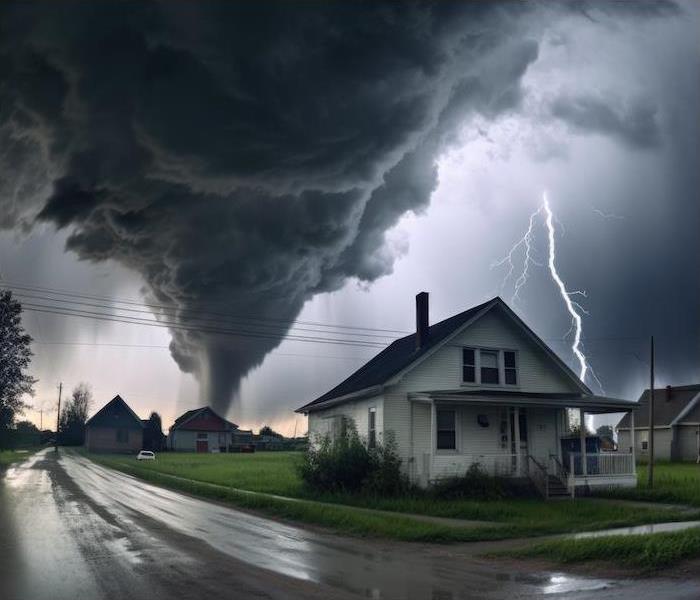 SERVPRO of Pewaukee & Sussex is Here to Help® after intense summer storms affect your home or business.
SERVPRO of Pewaukee & Sussex is Here to Help® after intense summer storms affect your home or business.
Tornadoes are among the most destructive forces of nature, leaving a trail of devastation in their wake. If your home or business in Pewaukee & Sussex has been impacted by a tornado, it’s crucial to assess the damage and take immediate action to begin the recovery process. Here are some essential tips for assessing tornado damage:
Initial Steps to TakeSafety First: Before assessing tornado damage, prioritize safety. Check for any immediate hazards such as downed power lines, gas leaks, or structural damage. If you suspect any danger, evacuate the premises and contact emergency services immediately. Once it’s safe to do so, proceed with caution when inspecting your property for damage.
Exterior Inspection: Begin by inspecting the exterior of your home or business for visible signs of damage. Look for structural damage such as missing roof shingles, damaged siding, broken windows, or fallen trees and branches. Take note of any areas where water may be entering the building. Document the damage with photographs or videos to provide evidence for insurance claims.
Interior Assessment: After assessing the exterior, it’s essential to inspect the interior for tornado-related damage. Check for water leaks, dampness, or signs of flooding in basements, crawl spaces, and attics. Look for water stains on ceilings or walls, warped flooring, or mold growth, indicating water intrusion. Take immediate action to mitigate water damage by extracting standing water and drying affected areas as soon as possible.
Mitigating Tornado DamageEmergency Repairs: Once you’ve assessed the extent of tornado damage, prioritize emergency repairs to prevent further damage to your property. Temporary fixes such as tarping roofs, boarding up windows, or sealing leaks can help prevent water intrusion and secure your home or business until permanent repairs can be made.
Water Damage Restoration: If your property has experienced water damage due to tornadoes, prompt action is crucial to prevent mold growth and structural issues. Contact a professional water damage restoration company like SERVPRO of Pewaukee & Sussex to assess the damage and initiate cleanup and restoration efforts. Our team has the expertise and equipment to extract standing water, dry affected areas, and restore your property to pre-tornado condition.
Content Restoration: Tornadoes can cause significant damage to personal belongings and business inventory. Work with SERVPRO of Pewaukee & Sussex to assess the damage to your belongings and determine which items can be salvaged through content restoration techniques such as cleaning, drying, and deodorizing. Our goal is to help you recover as much of your property as possible and restore it to its pre-tornado condition.
Partnering with SERVPRO of Pewaukee & SussexRecovering from tornado damage can be a challenging and overwhelming process, but you don’t have to face it alone. At SERVPRO of Pewaukee & Sussex, we understand the unique challenges homeowners and businesses face after tornadoes strike. Our team is here to provide expert tornado damage restoration services and support you every step of the way. Contact us today for immediate assistance and let us help you restore your property to its pre-tornado condition. Don’t wait – call SERVPRO of Pewaukee & Sussex now for reliable tornado damage restoration services.
Dealing with storm damage? Call SERVPRO of Pewaukee & Sussex for a quick restoration.
Preparing Your Home for Midwest Summer Tornado Season | SERVPRO of Pewaukee & Sussex
6/17/2024 (Permalink)
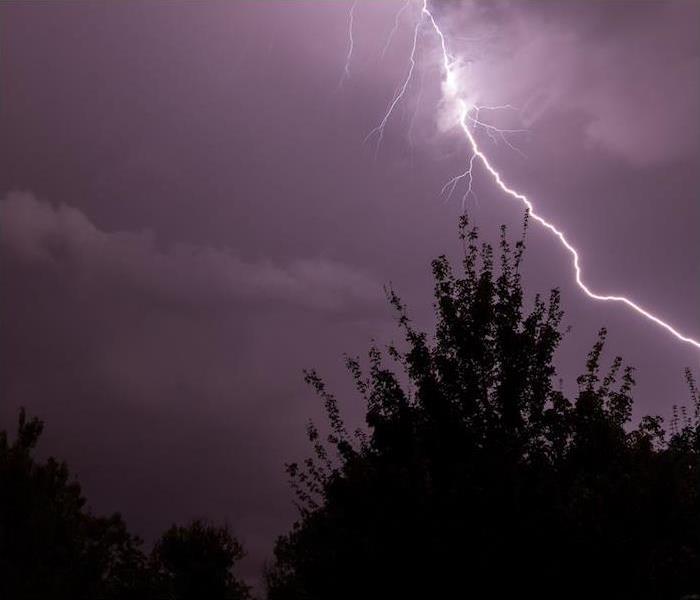 Whether its storm damage cleanup or restoration, SERVPRO of Pewaukee & Sussex is ready to respond in a moments notice to your call.
Whether its storm damage cleanup or restoration, SERVPRO of Pewaukee & Sussex is ready to respond in a moments notice to your call.
As summer approaches in the Midwest, we all must be vigilant and prepared for the onset of tornado season. These powerful storms can strike with little warning, causing widespread destruction and posing significant risks to life and property.
However, with proper preparation and understanding of tornado alerts, you can better protect your home and loved ones from the potential dangers.
Assess Your Home’s VulnerabilitiesBefore tornado season arrives, it’s essential to assess your home’s vulnerabilities and take proactive measures to strengthen its defenses. Start by inspecting your roof for any signs of damage or weakness, such as loose or missing shingles. Reinforce your roof if necessary to help it stay in place during strong storms.
Next, examine your windows and doors to ensure they are strong enough to withstand high winds and flying debris. Consider investing in impact-resistant windows or installing storm shutters to provide an extra layer of protection during tornadoes. Reinforce garage doors to prevent them from collapsing under pressure, as this can lead to significant structural damage.
Understanding Tornado Alerts: Watch vs. WarningIt’s essential to understand the difference between a tornado watch and a tornado warning to know how to respond appropriately during severe weather events.
Tornado Watch: A tornado watch is issued by the National Weather Service when weather conditions are favorable for the development of tornadoes. During a tornado watch, you should stay alert and be prepared to take action if a tornado warning is issued for your area. Keep an eye on weather updates and be ready to seek shelter immediately if necessary.
Tornado Warning: A tornado warning is issued when a tornado has been sighted or indicated by radar in your area. When a tornado warning is issued, it means that you need to take immediate action to protect yourself and your loved ones. Seek shelter in a safe room or basement, away from windows and exterior walls, and stay there until the storm has passed and it is safe to emerge.
Create a Tornado Preparedness PlanHaving a tornado preparedness plan in place is essential for ensuring the safety of your family during severe weather events. Designate a safe room or area in your home where you can take shelter during a tornado. Stock this area with emergency supplies, including water, non-perishable food, flashlights, batteries, a first-aid kit, and any necessary medications.
Make sure everyone in your household knows the location of the safe room and understands the importance of seeking shelter immediately when a tornado warning is issued. Practice tornado drills regularly so that everyone knows what to do and where to go in the event of a tornado.
Summer tornado season in the Midwest can be unpredictable and dangerous, but by taking proactive steps to prepare your home and family, you can increase your chances of staying safe and minimizing damage.
If your home is affected by a tornado or other severe weather event, SERVPRO of Pewaukee & Sussex is Here to Help®.
Storm Planning for a Confident and Calm Family | SERVPRO of Pewaukee & Sussex
5/15/2024 (Permalink)
 When the storm has passed, call SERVPRO of Pewaukee & Sussex to help you recover.
When the storm has passed, call SERVPRO of Pewaukee & Sussex to help you recover.
The sound of thunder and lightning fills the air while the tornado sirens blare. Your furry friend is restless and your children are anxious, leaving you unsure of what to do first. Storms can be quite terrifying, particularly in eastern Wisconsin during the late spring and summer.
We can’t control the weather. We can, however, control our preparedness and response to it, ensuring that everyone remains composed. This is particularly crucial for your young ones! Check out our team’s suggestions on how to integrate storm planning into your family’s routine for a stress-free response to any emergency.
Knowing What to Look ForWhile we can all tell the difference between sunny and cloudy days, not everyone knows how to spot potentially dangerous weather conditions. Even if there are no storm warnings, it’s crucial to keep an eye on the sky. Teach your kids to recognize the signs of an approaching storm, such as rotating clouds, a dark or green sky, rumbling thunder and lightning, and to head indoors immediately if they notice any of these concerning changes.
It’s also important for them to know what a tornado siren sounds like and when it may be activated. You can help them prepare for the sound during testing periods so that they become familiar with it and understand what it means. Encourage them to listen for the siren during testing days and time how long it takes for them to reach your designated safe shelter location.
Preparing for the EventOne of the most important emergency planning steps to take is to create an emergency plan with your family. Take the time to discuss the different scenarios and locate your safe shelter location together.
Your sheltering location should ideally be in an innermost room without windows, and you should be sure to keep it clear and ready to use at any time. If possible, pull a heavy desk or table into the room and have your kids practice getting under it by building a fort inside it or by playing a game under it.
Your kids can also help you pack your emergency kit! Start with the basic necessities by having your children choose what goes into the bag. Let them choose some of their favorite snacks and some shelf-stable water for each member of your family.
You can also have your child pick out a flashlight and label it with his or her own name. Don’t forget to toss in some extra batteries! Candles, matches and any necessary medications should also be added.
Finally, let your kids pick the fun items that will go inside! Special games, coloring books or other activities that are only used during emergency situations can make the whole experience a bit more positive.
Staying CalmSevere weather can be scary for anyone, but especially kids. It is natural to be apprehensive about storms, but it can also be helpful to learn more about them to ease your child’s anxieties. Explain to your little ones that the chances of suffering from serious damage during a tornado or strong storm are actually really low.
No matter the situation, focus on keeping your kids calm and distracted by staying calm yourself. Narrate the situation as the storm passes through, and keep your voice light-hearted. Together, you can all brave through scary storms with much more confidence.
Storm damage should always be addressed quickly. Contact SERVPRO® day or night for the restoration services you need.
Preparing for Floods With Confidence | SERVPRO of Pewaukee & Sussex
4/1/2024 (Permalink)
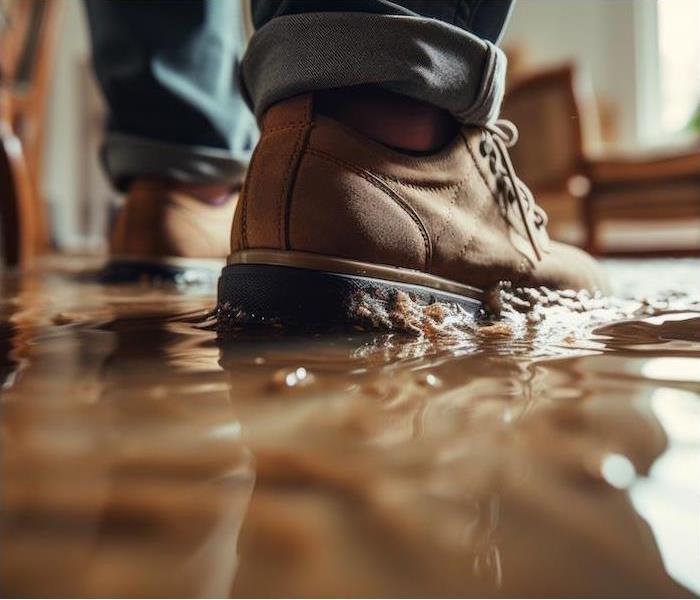 SERVPRO of Pewaukee & Sussex is ready to help in a moments notice after spring showers leak in to your home or business.
SERVPRO of Pewaukee & Sussex is ready to help in a moments notice after spring showers leak in to your home or business.
When tackling a tricky task, how do you approach it? Do you take it all on at once, or do you break it down to the basics and accomplish a little at a time? Sometimes taking things back to the beginning can help you tackle your situation with more confidence.
This is certainly true when it comes to preparing for severe weather and flood emergencies. Floods can be really impactful for our community, so knowing what to do when we are faced with flooding conditions can help you stay in control.
We explain some easy-to-follow flood prevention tips below to help your property stay dry when the spring rain comes to town.
Understanding Your Flood RiskFloods can happen when Mother Nature brings significant rain to our community, but that isn’t the only way that we can experience floods. Broken water lines, overflowing toilets or tubs, and leaky appliances can all pose serious issues for your home. In addition, our close proximity to Pewaukee Lake and other minor waterways can increase our risk of flooding from time to time.
We especially need to be aware in the springtime during a typical season as the snow melts and the runoff makes its way through our community. Do you know if your property is in a flood zone?
Whether your property is in a designated flood zone or not, it is still important that you know how your yard and home will react when it rains heavily or if we are in a flash flood watch. Low-lying areas can quickly fill up with water, so make sure you have your downspouts on and pointed away from your home and consider adding more length to the spouts to move the water even farther away from your home.
The tree coverage in our community is a blessing in many ways, but having so many leaves around your property can easily pose issues when it starts to rain. Leaves and other yard debris can quickly clog up a gutter, which can lead to pooling on your roof that can infiltrate your attic. Adding gutter covers can help keep that debris out so the water can flow where it needs to.
Additional PreparationWhile understanding your specific flood risk is important, we all know that Mother Nature has a mind of her own and that any one of us can be surprised by flooding issues at any time.
If you do suffer from a flood at any point, it can be really frustrating while also being informative at the same time. You can take steps like investing in a professional yard grading to help prevent it from happening again or you can do simple things like landscape around your home with mulch to help absorb excess moisture.
It can also help you keep a closer eye on the inside of your home. You should be checking your windows and doors regularly for signs of moisture and replacing any worn seals right away. In addition, you should also have your sump pump professionally inspected every season to make sure your equipment is ready to work no matter the season.
Start with the basics when it comes to flood prevention, and you will be amazed at how much of a difference it can make! Remember, our water damage restoration team is always here if you need us.
Do you have water damage in your home? Contact us at SERVPRO® for fast recovery.
Upgrading Your Weather Alert Systems This Spring | SERVPRO of Pewaukee & Sussex
3/1/2024 (Permalink)
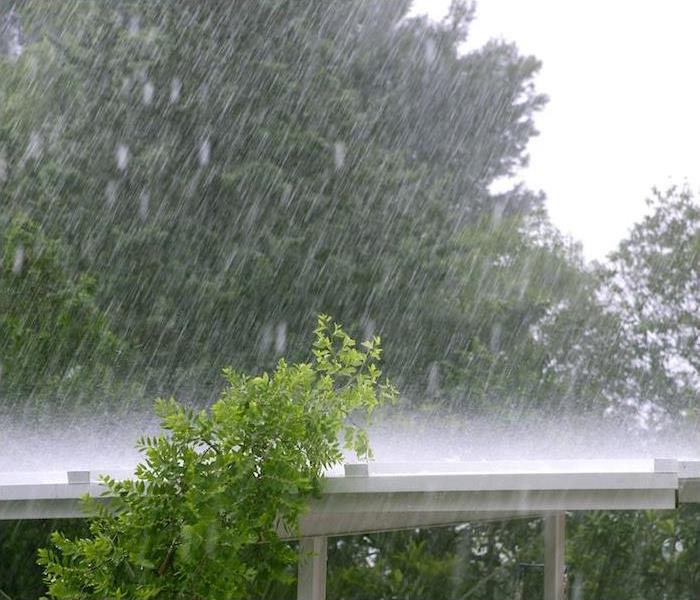 Let SERVPRO of Pewaukee & Sussex help you get from April showers to May flowers.
Let SERVPRO of Pewaukee & Sussex help you get from April showers to May flowers.
Spring weather is right around the corner if you can believe it! After the weirdly dry winter we experienced, we would bet that many of us are looking forward to spring rain showers and rumbling thunderstorms.
However, the arrival of spring weather means that severe weather season is on the horizon as well. Being prepared for severe weather like high winds or even tornadoes can help keep your family safe, so we explain some easy ways to make sure you are alerted and informed of any incoming weather.
Staying ConnectedMany of us spend our entire days surrounded by screens, so it should be no surprise that phones and TVs remain one of the most common ways of receiving weather alerts. Wireless Emergency Alerts are national alerts that can be issued directly to your phone, so check to make sure your notifications are turned on for this. You should also update any weather apps that you have to send you alerts based on your location.
Keep in mind that you should choose wisely when it comes to weather apps. Not every app should be trusted as many of them tend to inflate forecasts or over exaggerate them for likes or engagement. Stick to the nationally recognized organizations or trusted local sources instead.
That being said, TV stations and local weather authorities are also great resources when it comes to staying informed in real time. You can tune into one of our local stations to watch storms move across the area and you will be able to heed any warnings or sheltering recommendations as soon as they are issued.
When the Power Goes OutWhile the TV, phones and laptops can be really helpful during severe weather, they are only useful when we have power or if your devices are charged. Once the power goes out, it can put you in a really vulnerable position if you have no other ways of staying connected.
This is why you should have at least one other way of receiving alerts that does not rely on electricity in order to work. To start, you should know where the nearest weather siren is located and if you are able to easily hear it from your home.
In addition, you should also invest in an NOAA weather radio. Having a hand-crank or solar-powered radio in emergency situations will ensure you can still get the information you need in order to stay safe and stay informed.
We hope you all are ready for another exciting spring weather season! Remember that we are always here for you if your home or property suffers from storm damage. We will help you recover quickly no matter your situation.
Serious storms can cause serious property damage. Call SERVPRO® 24⁄7 for immediate restoration assistance.
The Danger of Compounding Home Damage | SERVPRO of Pewaukee & Sussex
12/1/2023 (Permalink)
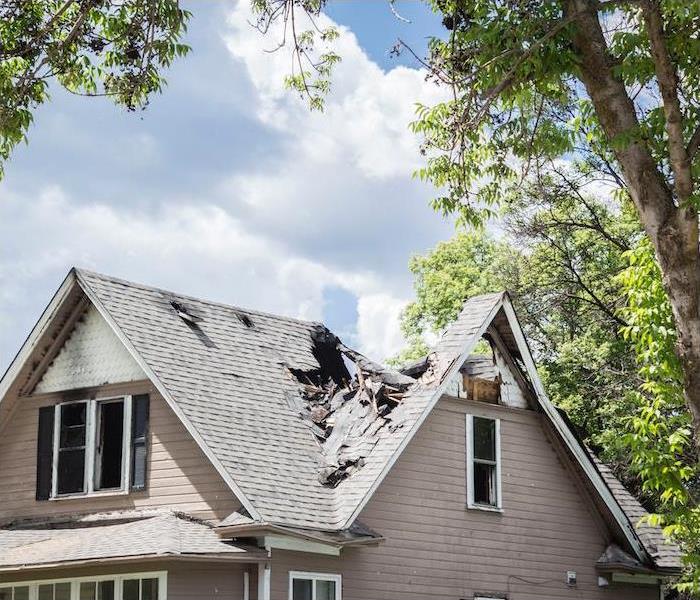 If you discover damage in your residence, call SERVPRO of Pewaukee & Sussex right away.
If you discover damage in your residence, call SERVPRO of Pewaukee & Sussex right away.
Our homes experience the threat of damage every day. The potential for volatile weather, fires and even unsuspected structural aging can lead to significant damage that needs to be addressed quickly.
While it can be scary to think about what could happen on any given day, knowing what to expect and how to react when something does happen can minimize your situation.
SERVPRO of Pewaukee & Sussex is always here to help you recover from disaster, so call us as soon as you discover damage. We explain more about the different damage situations that our community could suffer below.
The Biggest Threats to the Pewaukee AreaWe are lucky to experience all four seasons throughout the year, but that also means we are vulnerable to the different threats that come with each season. Storms and tornadoes can occur in the summer, heavy rain can make a big impact in the fall, blizzards and heavy snow can collapse roofs and cause other troubles in winter, and spring flooding can leave our basements soaked. In addition to weather events, regular home accidents like leaky pipes or house fires are also always a possibility.
Water damage can occur from storms or flooding, but it can also happen when appliances leak or if a seal around a water line gets worn down. Fire can also be caused by natural sources like lightning strikes, but house fires are much more likely to occur due to human error or negligence.
The Threat of Lingering DamageEach home damage situation can be frustrating to deal with, but unfortunately, your problem may only be just getting started. Lingering damage can lead to all kinds of issues. For example, a flooded basement will result in extensive water damage, but any sort of residual moisture will cause mold to grow that can affect your foundation or the structural integrity of your home.
The same is true for house fires. A single fire can lead to extensive damage that leaves your walls, floors and possessions burned, but lingering soot and smoke can make it to parts of your home that never were touched by the flames. On top of that, water damage is also a common issue with house fires due to the water or chemical agents used to extinguish the flames.
No matter what happens in your home, recovery is crucial. Our team is able to help you overcome damage faster, and we will work hard for you from start to finish.
If your home suffers a water disaster, our water damage restoration process will be thorough and efficient. We will remove the excess water, clean and sanitize your space, and tackle repairs quickly. We will also ensure any lingering odors are removed as well.
We will do the same for house fires. We will repair the burned areas of your home while tackling soot and smoke removal. Once your space is clean, we will address any water damage issues and start your reconstruction process. We can handle every aspect of your construction even if it involves tearing down a part of your house and rebuilding it.
We are a full-service restoration company, so you can relax and rest easy knowing that you only have to work with us in order to overcome your damage. There will be no need to coordinate repairs with multiple different contractors because we can handle it all for you in no time at all.
Does your home need restoration and you don’t want to make more than one call? Contact us to get everything handled by one team.
Storm Preparation Tips for the Pewaukee Area | SERVPRO of Pewaukee & Sussex
9/19/2023 (Permalink)
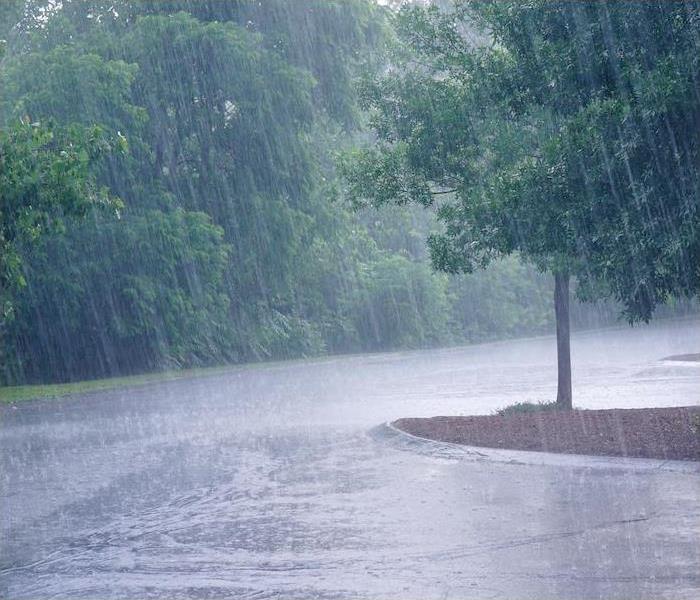 Have you been impacted by the unusual summer storm season? SERVPRO of Pewaukee & Sussex has your back when you experience flood and water damage.
Have you been impacted by the unusual summer storm season? SERVPRO of Pewaukee & Sussex has your back when you experience flood and water damage.
Summer in the midwest is certainly one of the best seasons across the country, in our opinion. The sun is out, the temperatures are (finally) warmer, and we are enjoying our cabins and cottages as often as possible.
Even though the summer season can be great, it is also a time of potentially dangerous weather. The heat and humidity can quickly bring wind, hail, heavy rain and tornadoes to the area without much forewarning.
In order to be prepared, you have to prepare! Storms can cause widespread damage if you are not taking the steps you need to in order to get your property ready now.
Preparing the outside of your home is an easy way to reduce the risk of suffering storm damage, so check out our tips below to learn more.
Seasonal Storm PreparationIf you are a homeowner, you already have a list of routine yard maintenance that you need to stay up on. The good news is that a lot of what you are already doing is helping prepare your home for storms.
Trimming your trees and removing yard debris like dead branches helps reduce your risk of suffering impact damage when the wind picks up. Cleaning out your gutters helps minimize the risk of suffering water damage, because the rainwater will be able to flow down and away from your home.
Once these tasks are done, focus on the entry points into your home. Check the seals around your doors and windows for signs of rot or deterioration, and do an inspection of your roof after every storm to check for broken or missing shingles.
Home Improvement PurchasesThankfully, most storm preparations can be done cost-free. However, there are some great products and equipment on the market that can help secure your home even more if you desire.
Storm shutters can be installed over your windows to protect them from breaking and leading to water and wind damage inside your house. If you live on a property with a lot of trees, gutter guards are good investments to help keep leaf debris from clogging up your gutter system.
Pole sheds and other outbuildings are also at risk of suffering storm damage. You can buy bracing or ties to secure the roof to protect it from damage, and depending on the size, you can invest in a gutter system for it as well.
Once your home is prepped and ready, stay current on the local forecast and always listen to warnings and alerts. If you do still end up suffering damage, SERVPRO of Pewaukee & Sussex is here to help guide you through a fast recovery.
Was your home damaged in a storm? Call us at SERVPRO of Pewaukee & Sussex to start restoration, 24⁄7.
Tips for Post-Storm Recovery in the Summertime | SERVPRO of Pewaukee & Sussex
9/19/2023 (Permalink)
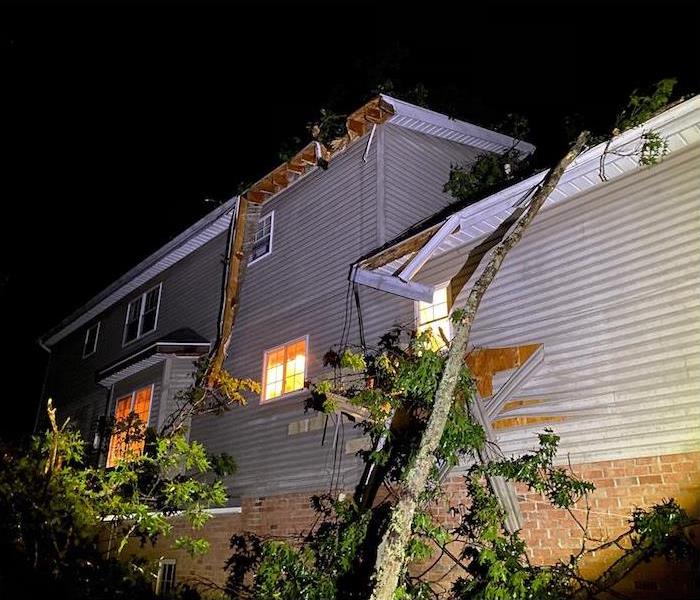 Summer storms affecting your property? Call SERVPRO of Pewaukee & Sussex to restore your space in no time!
Summer storms affecting your property? Call SERVPRO of Pewaukee & Sussex to restore your space in no time!
The summer season is great here in the Pewaukee area for many reasons, but severe storms sometimes aren’t one of them. While we may be grateful for the rain if our lawns and gardens are suffering, strong winds and hail can really do a number on our homes.
Strong thunderstorms can easily develop and roll across the state during those hot and humid days during the summer. When the sun shines in the morning, it increases our chances of experiencing a severe storm with high wind, heavy rain and damaging hail. Even the occasional tornado is known to happen from time to time around the Pewaukee area.
Your family’s safety should always be your top priority during these types of situations, so keep an eye on the sky and head inside as soon as the weather starts to turn.
Once the storm has blown through, it’s time to inspect your property for damages. Check out our helpful tips for recovering after a storm below to help you stay on track and stay safe.
Immediately Following the ThunderstormDon’t run outside quite yet! Another storm could be on the horizon, so stay sky-aware and stay close to home until you are certain the threat has passed. Keep your weather radio or phone handy to listen for updates or another storm alert.
If there was anyone in your family or household that was not home when the storm hit, take this time to connect with them to make sure they are safe. Sending off a quick text can bring everyone some peace of mind.
You should also check on your neighbors when you have a chance. The path of storms can be very unpredictable and cause varying degrees of damage in a single neighborhood. Just be cautious moving around any homes or buildings with visible damage.
Once everyone is safe and accounted for, it’s time to start some damage control. Take photos of whatever damage you find and call SERVPRO of Pewaukee & Sussex right away for immediate assistance.
The Minutes and Hours Post-StormIf your home has been damaged in any way, be extremely cautious walking around your home and property. Some damage can be severe enough to affect your home’s structural integrity, while loose boards and shattered glass can be hazards all on their own. Keep your cell phone close by and make sure someone knows where you are at all times.
If it is still raining or is really windy, you might need to start securing your home before we even get there. Laying tarps and covering broken windows can help protect your possessions from further damage. We will do this step as well when we arrive but the more you do right away, the better it will be for everyone involved.
We are proud to be able to work directly with your insurance company while simultaneously working on drying and restoring your home. This ensures that your claim is being processed correctly, and you are getting the most accurate damage reports in real time.
We know that suffering home damage during a storm can be scary and overwhelming, but we are here to make sure that your space is returned to exactly the way it was before the storm and we will keep working until you are 100% satisfied with the final product.
If a storm leaves your home damaged, contact us for fast recovery. We’re here 24⁄7 when you need us.
Protect Your Home From the Strong Summer Wind | SERVPRO® of Pewaukee & Sussex
6/9/2023 (Permalink)
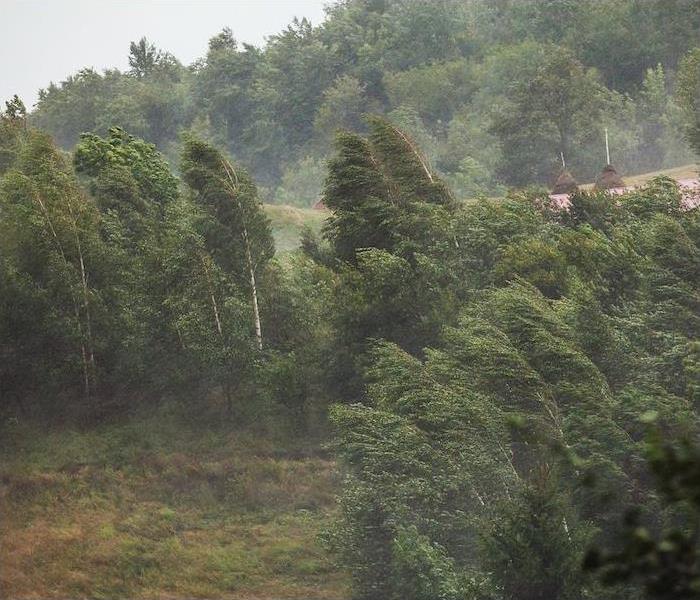 If you've suffered from storm-related damage to your home or business, make SERVPRO of Pewaukee & Sussex your first call.
If you've suffered from storm-related damage to your home or business, make SERVPRO of Pewaukee & Sussex your first call.
We all enjoy a soft breeze on a warm summer’s day, but we would bet that not many of us enjoy the wind that accompanies a severe thunderstorm or tornado. Those situations can often be scary and even dangerous when they occur.
Wind can impact our homes in a variety of ways, and it can lead to disastrous effects if we are not careful. While we associate wind damage most often with storms, it can even happen on a sunny day if it is blowing hard enough.
Get to know more about the different types of strong winds below so you can keep your family safe and property free of damage.
Varying Wind StrengthsThe majority of damaging winds come when thunderstorms are in the area, and even more so when a tornado touches down nearby.
Thunderstorms can produce a variety of different weather threats, and they can easily kick up winds up to 60 miles per hour. At that speed, yard debris can be blown about and tossed against your home.
Straight-line winds are also problematic! This type of wind has no rotation to it, which means it can occur in powerful bursts and cause widespread damage with a single gust. Straight-line winds can blow up to 100 miles per hour.
Tornadoes are one step above that and can contain downdrafts, straight-line winds and bursts of wind called micro- or macro-bursts. All of these different types can lead to a dangerous and even deadly situation.
We certainly see our fair share of dangerous weather in the summer and early fall. Severe thunderstorms with strong winds can quickly appear on the radar, even when the entire day was previously sunny! This is why it is crucial to understand the forecast whenever you are going outside.
Tips to Avoid Wind DamageWhen the wind blows strongly enough, it can take out trees, toss around heavy yard debris and damage power lines. It can even upend mobile homes and cars if it blows over 80 miles per hour!
In order to have as much advance notice about a developing weather situation, you need to have a way to be alerted to changing conditions. Once the wind advisory or warning is issued, it is time to get ready. Move loose objects inside your home or garage, and tie down the things that are permanently outside, like your grill and propane tanks.
Try to keep your trees trimmed throughout the year, and certainly remove any hanging branches or broken limbs before the wind picks up. A branch can easily become a dangerous projectile at the right speed.
Head to an interior room to ride out the storm and stay away from windows and only leave your sheltering location once you are sure the threat has passed.
Take a walk around your property to look for damage, paying special attention to your roof. If you do discover any sort of storm damage, call SERVPRO of Pewaukee & Sussex right away! We can get your home back together quickly and efficiently.
Has your home been damaged by wind? Call us and get things cleaned up fast.
The Importance of Spring Weather Preparation | SERVPRO® of Pewaukee & Sussex
3/10/2023 (Permalink)
 SERVPRO of Pewaukee & Sussex team is always here for you, if you experience any storm damage call us right away.
SERVPRO of Pewaukee & Sussex team is always here for you, if you experience any storm damage call us right away.
As spring weather is just within our grasp, it is important to start making the changes and preparations needed in order to keep your home dry and free of storm damage when the first spring thunderstorms come rolling in.
Storm damage can cause widespread issues really quickly throughout your home, so now is the time to address any issues that appeared over the winter season and get your home ready for the rain!
Keep It FlowingOver the course of the winter season, any thaws we had may have felt nice, but they could have been contributing to ice buildup along your roof line and in your gutters. If your gutters can’t flow, water will back up onto your roof. Remove debris and clear the ice when you are able so your gutters can work properly for you.
If you haven’t been checking on your vents continually this winter, do it now! The vents leading outside from your furnace, dryer and even in your attic can become blocked or glazed over with ice or snow. Make sure you clear any blockages so the vents can do their job and simultaneously keep your family safe from danger.
It is also really important to do a thorough check of your outdoor water lines and faucets. Any exposed piping has the potential to freeze and expand if water was caught inside. If the expansion becomes too much, the pipe can burst and can be a massive water issue when the temperatures warm up.
Quickly Fix the IssuesIf you do find any sort of damage around your home, now is the time to fix the problem! The longer you wait, the higher the risk of suffering severe damage. This includes inspecting your roof and doing any necessary repairs right away.
Look for missing shingles, broken gutters or visible damage due to a fallen tree or debris. It doesn’t take much for water to get into your attic and cause havoc throughout your house.
Get Ready for Impending WeatherWith spring showers comes more rain, right? However the saying goes, we all know that springtime can be wet and rainy. If you have a sump pump in your home, make sure it is ready to work ahead of the first spring rainstorm. This can help keep your basement dry throughout the entire season and beyond.
In addition to preparing your home, make sure your family is prepared as well. Go over your storm safety plan and discuss where your safe shelter location is. If any boxes or storage items were put in this location for the winter, find a new home for them during this season. Finally, update and edit your emergency kit to reflect any changes to your family’s needs.
Remember, we are always here for you no matter what season it is! Just call SERVPRO of Pewaukee & Sussex if you experience water or storm damage, and we will work hard to return your home to its preloss state as fast and efficiently as we can.
Got water damage? We are here to help 24⁄7 and can restore your home quickly.
When you suffer storm-related damage to your home or business, make SERVPRO of Pewaukee & Sussex your first call.
8/18/2022 (Permalink)
Storm damage is a very real concern for all homeowners. When a storm is in the area, it can make everyone anxious. Unfortunately, experiencing some sort of storm damage is likely at some point during your lifetime.
That being said, just because a storm is coming our way doesn’t mean that you are guaranteed to suffer damages! It all depends on the category of the storm, the location of your home in town and how well-built your home is.
In eastern Wisconsin, we are at risk of severe warm-weather events like tornadoes and severe thunderstorms as well as cold-weather threats like winter storms and freezing rain. We love the Midwest!
When one of these weather events comes to town, we are at risk of three major damages occurring:
Wind
Wind accompanies summer and winter weather. If it blows fast enough, it can cause widespread damage.
While it is true that tornadoes produce some of the highest wind speeds, wind from thunderstorms can be just as devastating. In fact, wind from storms can be over 100 mph.
Strong-enough winds can uproot trees and throw around debris in your yard. Stay inside and avoid windows until the storm has passed and the wind has died down.
Taking the time ahead of the arrival of any storm to clean up your yard and remove any trees or untethered furniture can help reduce your risk of suffering damage due to the wind.
Water
Water can be a great resource from thunderstorms if we are in need of rain for our lawns and gardens, but a lot of it can do incredible damage to your home.
It can leak through windows and down into our basements. And if your basement continually gets wet after storms, it can degrade your foundation and cause mold growth.
Grade your property, and if you do any landscaping, make sure your yard slopes away from your home to prevent water from pooling near your foundation. You can also research building a rain garden! Rain gardens are a great place for all of that unwanted water to flow to.
Your gutters need special attention as well! Blocked gutters can’t function properly and can let water pool on your roof that will eventually leak down your walls.
Impact
When it comes to impact damages, they can be costly and devastating. “Impact damage” come in the form of a fallen tree or some other type of object being thrown into the side of your home.
To prevent this kind of damage, do your best to keep your property free of any external hazards like dead trees or large hanging limbs. Tie down or otherwise secure furniture and other objects left outdoors during a storm to keep them from becoming projectiles.
Overcoming weather-related disasters of any kind is expensive. In fact, in 2021, it was reported that Americans suffered $145 billion in damages to their homes.
If you do discover damage to your home or property after a storm, call us at SERVPRO of Pewaukee & Sussex right away. Our dedication to your restoration will be unmatched, and we will get you back into your home right away.
When you suffer storm-related damage to your home or business, it’s important that you know who to call! Contact us today at (262) 696-6336 to get your storm damage restoration started faster.
Making a Plan/Kit For You & Your Pets for an Emergency
6/29/2021 (Permalink)
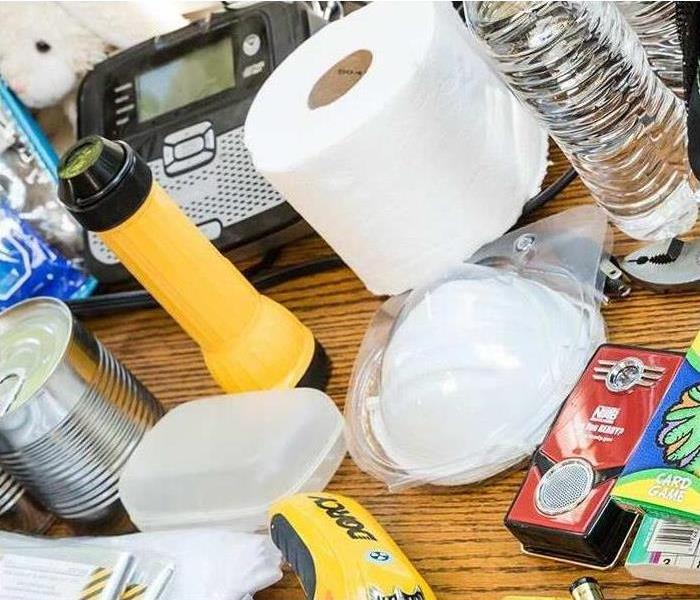 Examples of kit items
Examples of kit items
Make a Plan, Be Prepared.
Being prepared for an emergency event is a very responsible task you can do for you, your family, and your pets.
Make a Plan
-Put a plan together by discussing the questions below with your family, friends or household to start your emergency plan.
-How will I receive emergency alerts and warnings?
-What is my shelter plan?
-What is my evacuation route?
-What is my family/household communication plan?
-Do I need to update my emergency preparedness kit?
-Remember, during a disaster what’s good for you is good for your pet, so get them ready today.
If you leave your pets behind, they may be lost, injured or worse. Never leave a pet chained outdoors.
Remember, during a disaster what’s good for you is good for your pet, so get them ready today.
If you leave your pets behind, they may be lost, injured or worse. Never leave a pet chained outdoors. Plan options include:
-Create a buddy system in case you’re not home. Ask a trusted neighbor to check on your animals.
Identify shelters. For public health reasons, many emergency shelters cannot accept pets.
-Find pet friendly hotels along your evacuation route and keep a list in your pet’s emergency kit.
Locate boarding facilities or animal hospitals near your evacuation shelter.
-Consider an out-of-town friend or relative.
-Locate a veterinarian or animal hospital in the area where you may be seeking temporary shelter in case your pet needs medical care. Add the contact information to your emergency kit.
-Have your pet microchipped and make sure that you not only keep your address and phone number up-to-date, but that you also include contact info for an emergency contact outside of your immediate area.
-Call your local emergency management office, animal shelter or animal control office to get advice and information.
-If you are unable to return to your home right away, you may need to board your pet. Find out where pet boarding facilities are located.
-Most boarding kennels, veterinarians and animal shelters will need your pet's medical records to make sure all vaccinations are current.
-If you have no alternative but to leave your pet at home, there are some precautions you must take, but remember that leaving your pet at home alone can place your animal in great danger.
BUILDING A KIT:
To assemble your kit store items in airtight plastic bags and put your entire disaster supplies kit in one or two easy-to-carry containers such as plastic bins or a duffel bag.
A basic emergency supply kit could include the following recommended items:
-Water (one gallon per person per day for at least three days, for drinking and sanitation)
-Food (at least a three-day supply of non-perishable food)
-Battery-powered or hand crank radio and a NOAA Weather Radio with tone alert
-Flashlight
-First aid kit
-Extra batteries
-Whistle (to signal for help)
-Dust mask (to help filter contaminated air)
-Plastic sheeting and duct tape (to shelter in place)
-Moist towelettes, garbage bags and plastic ties (for personal sanitation)
-Wrench or pliers (to turn off utilities)
-Manual can opener (for food)
-Local maps
-Cell phone with chargers and a backup battery
Include basic survival items and items to keep your pet happy and comfortable. Start with this list to find out exactly what items your pet needs to be Ready.
Your pet kit should include:
-Food (at least a three day supply in an airtight, waterproof container)
-Water (at least three days of water specifically for your pets)
-Medicines
-Medical records, proof of vaccinations, registration and adoption documents (talk to your veterinarian about microchipping)
-First aid kit (cotton bandage rolls, bandage tape and scissors, antibiotic ointment, flea and tick prevention, latex gloves, isopropyl alcohol, saline solution and a pet first aid reference book)
-Collar or harness with ID tag, rabies tag and a leash
-Crate or pet carrier (a sturdy, safe crate or carrier large enough for your pet to stand, turn around and lie down)
-Sanitation needs (litter box and litter, newspapers, paper towels, plastic trash bags and household chlorine bleach)
-A picture of you and your pet together to prove ownership (add species, breed, age, sex, color and distinguishing characteristics)
-Familiar items (treats, toys and bedding can help reduce stress for your pet)
Being safe and prepared is not only a good idea, but a safe one.
*Source: ready.gov
What equipment is used to extract water from my Pewaukee, Wisconsin home after a Water Damage?
6/16/2021 (Permalink)
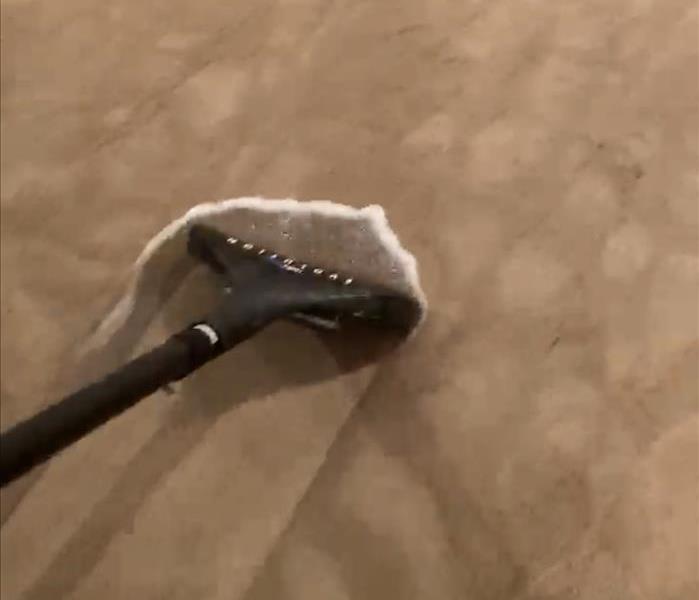 Carpet Wand extracting water caused by a flood in a Pewaukee residence
Carpet Wand extracting water caused by a flood in a Pewaukee residence
Water Damage Caused by Flooding
Once your home or commercial property gets water damage due to flooding, our crew will come out to access the damage. We will need to extract the water from your property because extraction is a critical step to removing moisture from a structure. The more excess water restorers remove with extraction equipment, the less time they will spend to evaporate and dehumidify the remaining moisture with drying equipment. Various types of extraction tools are used to remove water from flooring. These are:
- extraction units
- light wands
- deep extraction tools
- submersible pumps
Extraction Units
Extractors can be portable units or large truck-mounted units.
A portable extractor is extremely flexible since it can be taken into almost any area of the structure. They do require electricity to operate, so power will have to be provided from the facility or a generator.
Truck-mounted extractors offer a more powerful vacuum compared to portables. They run off the work vehicle’s fuel, so no on-site power is needed
Light Wands
Light wands or “carpet wands” are used for water extraction. The light wand is appropriate for the initial water removal and extracting water from glue-down carpet. It is also effective in removing residual water on the surface of carpets after a stationary tool has been used. When the pad is being removed, the light wand is appropriate since you are not trying to remove all the water from the pad.
Deep Extraction Tools
There are various types of deep extraction tools that can be attached to an extractor.
Self-propelled extraction tools are powered by an independent motor that moves the unit over carpet at a consistent rate. These devices compress carpet and pad, squeeze out water, and remove water through the vacuum system of an extractor.
Stationary tools are able to extract water from carpet and pad using only the weight of the water damage restoration professional standing upon the device. A vacuum system is attached to the device, pulling water through a series of tiny holes in the base of the unit. Stationary tools are available in various sizes.
If you have water damage due to a flood in your Pewaukee or Sussex home, call SERVPRO of Pewaukee & Sussex.
262.696.6336.
Hurricane Prep Week Day 4
5/13/2021 (Permalink)
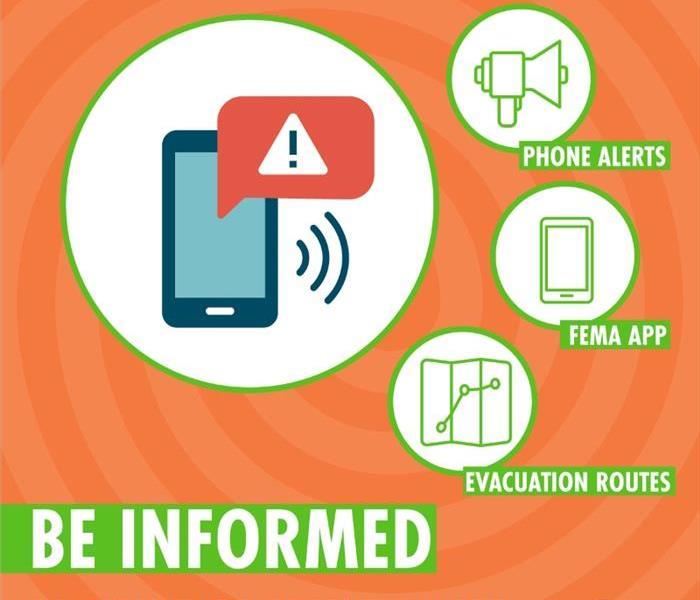 Hurricane Prep Week Day 4
Hurricane Prep Week Day 4
Being prepared for a disaster such as a hurricane can make all the difference in safety as well as damages. Each day this week we will be posting tips that can help you be prepared for a hurricane or any other major event. There is always comfort in having peace of mind knowing that you are ready.
Day 4 of Hurricane Prep Week is about having an evacuation plan. You should plan your route and have an alternate route in case the first one is not accessible. You may have to evacuate quickly, so you should practice with your household and your pets. You should also remember that you may not have to drive hundreds of miles to evacuate, only far enough away from the evacuation area.
Hurricane Prep Week Day 2
5/11/2021 (Permalink)
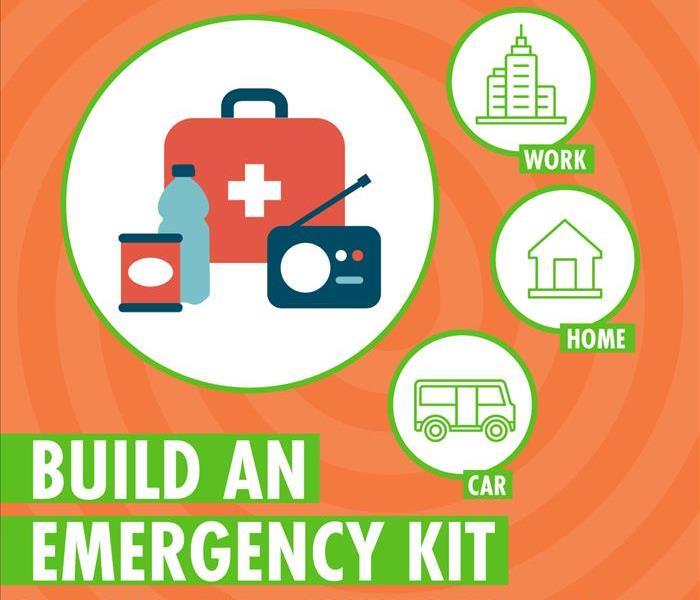 Hurricane Prep Week Day 2
Hurricane Prep Week Day 2
Being prepared for a disaster such as a hurricane can make all the difference in safety as well as damages. Each day this week we will be posting tips that can help you be prepared for a hurricane or any other major event. There is always comfort in having peace of mind knowing that you are ready.
Day 2 of Hurricane Prep Week is about having an emergency kit ready at work, in your car, and at home. This could include a backpack, water, non-perishable food, a blanket, etc. The best place to store the kit is somewhere that you will go to take shelter. Having all your materials in one place and storing them in your shelter location means that you don’t have to worry about getting prepared when a warning is issued. You’re already prepared and can just focus on getting yourself to your shelter. To learn more about what to put in your kit visit https://www.weather.gov/owlie/emergencysupplieskit
Flood basements in the Pewaukee and Waukesha Area
5/7/2021 (Permalink)
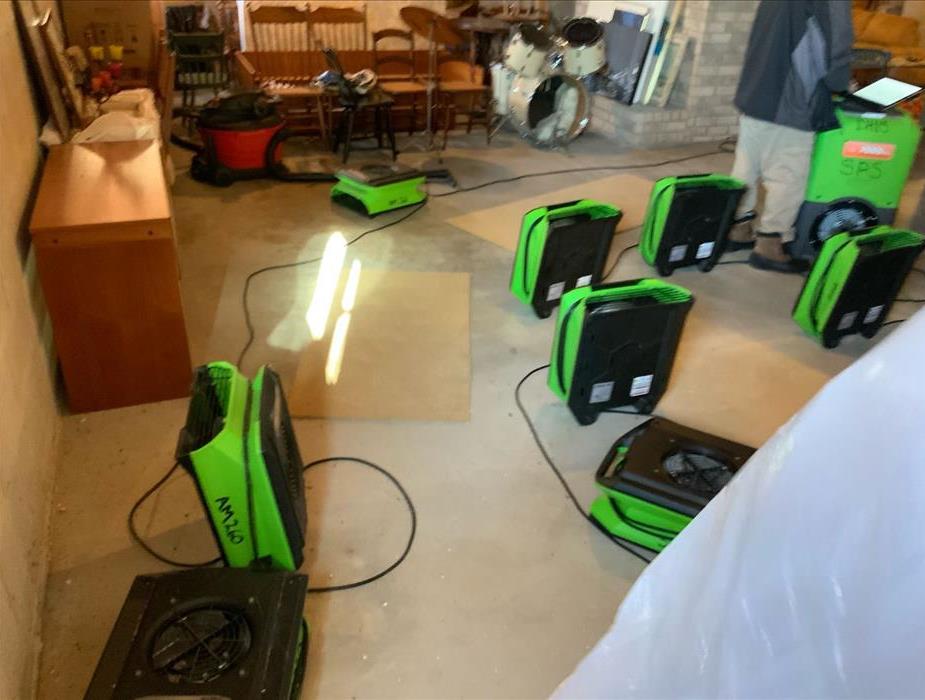 This Pewaukee's basement flooded due to heavy rains
This Pewaukee's basement flooded due to heavy rains
A basement can flood at any time, although flooding most often occurs during heavy rainfall. Basements are inherently prone to flooding because they are the lowest level of a building and are normally built partly or entirely below ground level. There are a number of reasons why your Pewaukee or Sussex basement could flood, including:
- A blocked or failed sewer lateral pipe
- Heavy rain causes surface water to pool around your home
- Storm sewer backup
- Sanitary sewer backup
- Foundation drainage failure
- Water supply-line break or hot-water tank failure
- And many more
Have Questions about Basement Flooding?
Call Today - 262.696.6336.
If flood water is not handled quickly and properly, it can jeopardize your health and safety, and cause severe damage to your home’s structure. Remember, the longer you wait, the worse the problem will get.
The bottom line: a flooded basement can jeopardize your health, safety, and your home’s integrity. It’s worth making a call to SERVPRO of Pewaukee & Sussex and let our trained, professional crews handle the situation safely and correctly. We have earned the trust of hundreds of homeowners, business owners, and property professionals.
We are Flooded Basement Specialists:
- We are Available 24 hours/7 days per week
- We’re a Preferred Vendor to many National Insurance Companies
- We Bill The Insurance Directly – One Less Thing For You To Worry About
- Our Technicians are Highly-Trained in Water Restoration Techniques
- We use s500 IICRC Restoration Standards
- Advanced Inspection and Extraction Equipment
Basement Flooded? Call Us Today – We’re Ready To Help 262.696.6336
Water Damaged Home in Hartland, Wisconsin
1/29/2021 (Permalink)
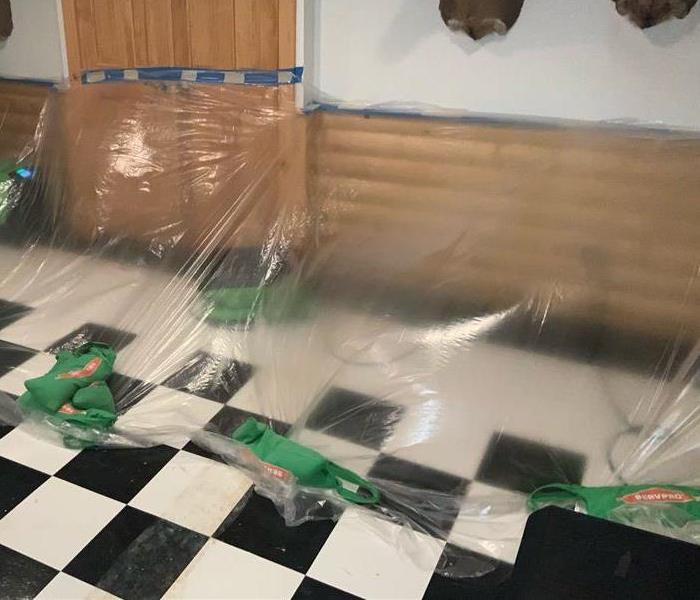 Drying Chamber for Wood Paneling
Drying Chamber for Wood Paneling
As you can see in the photo, a property had flooded due to a recent storm event. SERVPRO of Pewaukee and Sussex set up a drying chamber around the wood paneling and the drywall that was behind it. When you need to isolate a certain area for drying treatment, then this is where drying chambers come into play. They allow you to manipulate the humidity, airflow, and temperature. The affected area becomes limited to external, environmental factors due to the polyethylene barrier that surrounds it. By reducing the volume of the drying area by creating your chamber, it can speed up drying time as well as save you from pulling out additional materials if not needed.
If your property has suffered a water damage, give SERVPRO of Pewaukee and Sussex a call today at 262.696.6336.
Decent Snowfall Expected in Waukesha County
1/25/2021 (Permalink)
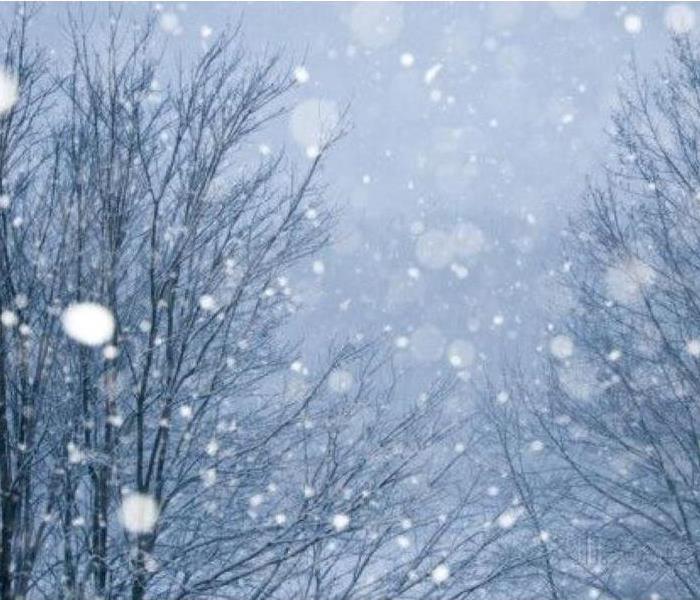 Snow Falling
Snow Falling
Waukesha county and south eastern Wisconsin is expected to get a decent accumulation of snow. The winter weather advisory will go into effect at 6 PM on Monday, January 25. The snow will start to accumulate from early Monday evening and continue until Tuesday evening. Expected snowfall is anywhere from three to six inches. This snowfall could impact travel- making it difficult. Patchy blowing snow could significantly reduce visibility. The hazardous conditions could impact the morning or evening commute so drive with precaution. The latest road conditions for the state you are calling from can be obtained by calling 511. If you do succumb to nasty weather conditions, just remember to pull over, put your hazards on, call for help and stay in your car until help arrives.
Preparing for a Winter Storm Event
1/15/2021 (Permalink)
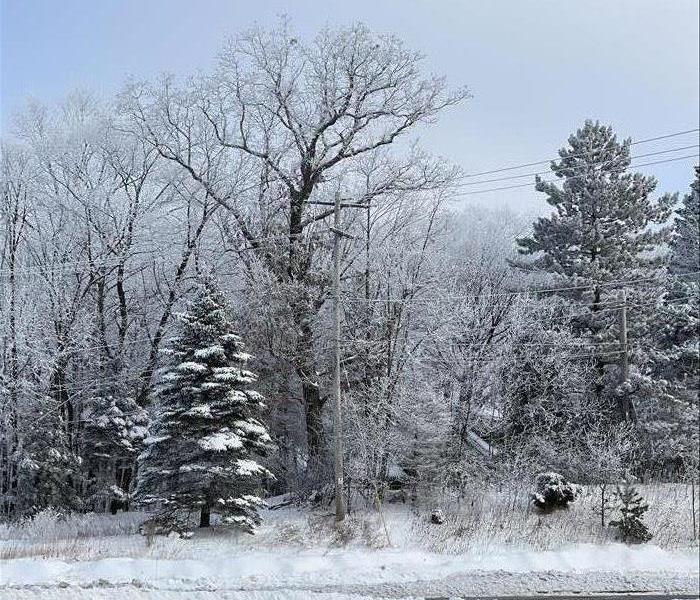 Snow and Ice formed on trees
Snow and Ice formed on trees
Living in Pewaukee, Wisconsin you and your family have to be prepared for the wild weather that we experience- especially in our winter months! Winter storms including blizzards can bring extreme cold, freezing rain, snow, ice and high winds.
Things to consider:
- Check your tires and check tire pressure.
- Get a vehicle winter maintenance check-up.
- Keep your fuel tank full.
- Program your radio for traffic reports and emergency messages.
- Keep a basic winter survival kit in your vehicle: flashlight, batteries, phone charging bank, blanket, snacks, water, gloves, boots, first-aid kit.
- Load your car with winter travel gear: tire chains, ice scraper/snowbrush, jumper cables, road flares.
If you do end up stranded be sure to engage your flashers, call for help and wait in your car until the help arrives.
*Source: wsdot.com
Making a Plan/Kit For You & Your Pets for an Emergency
6/29/2020 (Permalink)
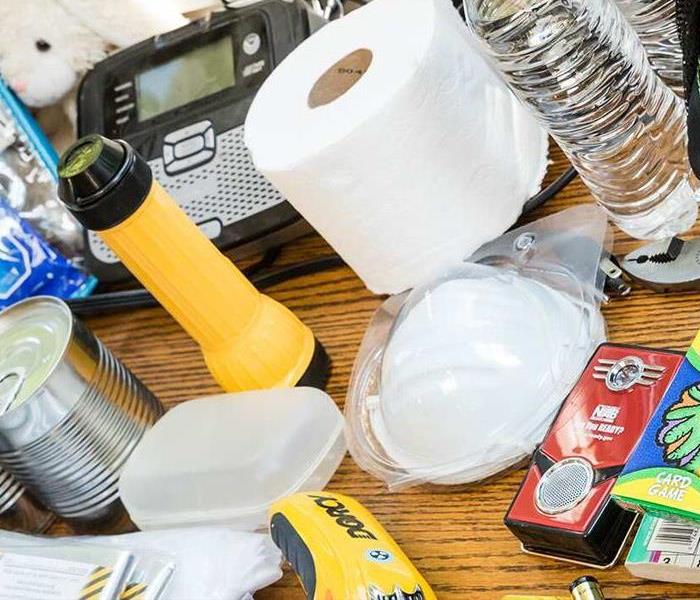 Examples of kit items
Examples of kit items
Being prepared for an emergency event is a very responsible task you can do for you, your family, and your pets.
Make a Plan
Put a plan together by discussing the questions below with your family, friends or household to start your emergency plan.
- How will I receive emergency alerts and warnings?
- What is my shelter plan?
- What is my evacuation route?
- What is my family/household communication plan?
- Do I need to update my emergency preparedness kit?
Remember, during a disaster what’s good for you is good for your pet, so get them ready today.
If you leave your pets behind, they may be lost, injured or worse. Never leave a pet chained outdoors.
Remember, during a disaster what’s good for you is good for your pet, so get them ready today.
If you leave your pets behind, they may be lost, injured or worse. Never leave a pet chained outdoors. Plan options include:
- Create a buddy system in case you’re not home. Ask a trusted neighbor to check on your animals.
- Identify shelters. For public health reasons, many emergency shelters cannot accept pets.
- Find pet friendly hotels along your evacuation route and keep a list in your pet’s emergency kit.
- Locate boarding facilities or animal hospitals near your evacuation shelter.
- Consider an out-of-town friend or relative.
- Locate a veterinarian or animal hospital in the area where you may be seeking temporary shelter in case your pet needs medical care. Add the contact information to your emergency kit.
- Have your pet microchipped and make sure that you not only keep your address and phone number up-to-date, but that you also include contact info for an emergency contact outside of your immediate area.
- Call your local emergency management office, animal shelter or animal control office to get advice and information.
- If you are unable to return to your home right away, you may need to board your pet. Find out where pet boarding facilities are located.
- Most boarding kennels, veterinarians and animal shelters will need your pet's medical records to make sure all vaccinations are current.
- If you have no alternative but to leave your pet at home, there are some precautions you must take, but remember that leaving your pet at home alone can place your animal in great danger.
Build a Kit
To assemble your kit store items in airtight plastic bags and put your entire disaster supplies kit in one or two easy-to-carry containers such as plastic bins or a duffel bag.
A basic emergency supply kit could include the following recommended items:
- Water (one gallon per person per day for at least three days, for drinking and sanitation)
- Food (at least a three-day supply of non-perishable food)
- Battery-powered or hand crank radio and a NOAA Weather Radio with tone alert
- Flashlight
- First aid kit
- Extra batteries
- Whistle (to signal for help)
- Dust mask (to help filter contaminated air)
- Plastic sheeting and duct tape (to shelter in place)
- Moist towelettes, garbage bags and plastic ties (for personal sanitation)
- Wrench or pliers (to turn off utilities)
- Manual can opener (for food)
- Local maps
- Cell phone with chargers and a backup battery
Include basic survival items and items to keep your pet happy and comfortable. Start with this list or download Preparing Makes Sense for Pet Owners-Emergency Preparedness Pet Kit List (PDF) to find out exactly what items your pet needs to be Ready.
Your pet kit should include:
- Food (at least a three day supply in an airtight, waterproof container)
- Water (at least three days of water specifically for your pets)
- Medicines
- Medical records, proof of vaccinations, registration and adoption documents (talk to your veterinarian about microchipping)
- First aid kit (cotton bandage rolls, bandage tape and scissors, antibiotic ointment, flea and tick prevention, latex gloves, isopropyl alcohol, saline solution and a pet first aid reference book)
- Collar or harness with ID tag, rabies tag and a leash
- Crate or pet carrier (a sturdy, safe crate or carrier large enough for your pet to stand, turn around and lie down)
- Sanitation needs (litter box and litter, newspapers, paper towels, plastic trash bags and household chlorine bleach)
- A picture of you and your pet together to prove ownership (add species, breed, age, sex, color and distinguishing characteristics)
- Familiar items (treats, toys and bedding can help reduce stress for your pet)
Being safe and prepared is not only a good idea, but a safe one.
*Source: ready.gov
What Equipment is used to Extract Water from my Pewaukee or Sussex Home After a Flood?
6/16/2020 (Permalink)
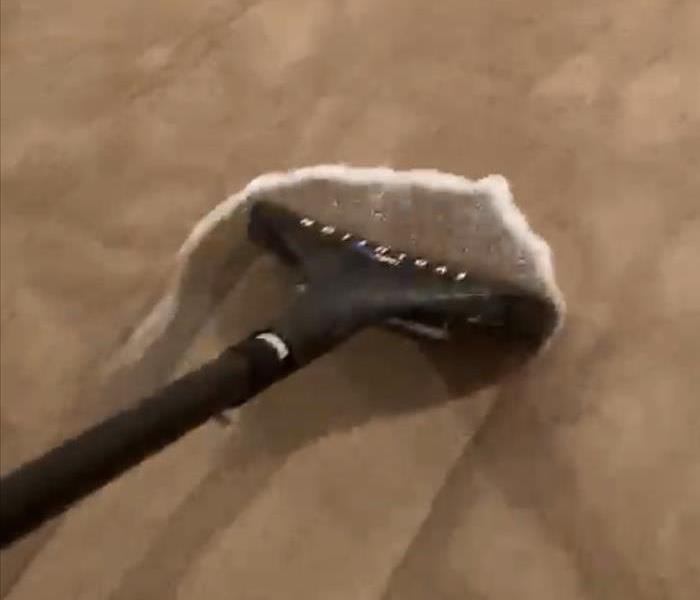 Carpet Wand extracting water cause by a flood in a Pewaukee residence.
Carpet Wand extracting water cause by a flood in a Pewaukee residence.
Water Damage Caused by Flooding
Once your home or commercial property gets water damage due to flooding, our crew will come out to access the damage. We will need to extract the water from your property because extraction is a critical step to removing moisture from a structure. The more excess water restorers remove with extraction equipment, the less time they will spend to evaporate and dehumidify the remaining moisture with drying equipment. Various types of extraction tools are used to remove water from flooring. These are:
- extraction units
- light wands
- deep extraction tools
- submersible pumps
Extraction Units
Extractors can be portable units or large truck-mounted units.
A portable extractor is extremely flexible since it can be taken into almost any area of the structure. They do require electricity to operate, so power will have to be provided from the facility or a generator.
Truck-mounted extractors offer a more powerful vacuum compared to portables. They run off the work vehicle’s fuel, so no on-site power is needed
Light Wands
Light wands or “carpet wands” are used for water extraction. The light wand is appropriate for the initial water removal and extracting water from glue-down carpet. It is also effective in removing residual water on the surface of carpets after a stationary tool has been used. When the pad is being removed, the light wand is appropriate since you are not trying to remove all the water from the pad.
Deep Extraction Tools
There are various types of deep extraction tools that can be attached to an extractor.
Self-propelled extraction tools are powered by an independent motor that moves the unit over carpet at a consistent rate. These devices compress carpet and pad, squeeze out water, and remove water through the vacuum system of an extractor.
Stationary tools are able to extract water from carpet and pad using only the weight of the water damage restoration professional standing upon the device. A vacuum system is attached to the device, pulling water through a series of tiny holes in the base of the unit. Stationary tools are available in various sizes.
If you have water damage due to a flood in your Pewaukee or Sussex home, call SERVPRO of Pewaukee & Sussex.
262.696.6336.
Storm Damage at your Pewaukee or Sussex Property
6/8/2020 (Permalink)
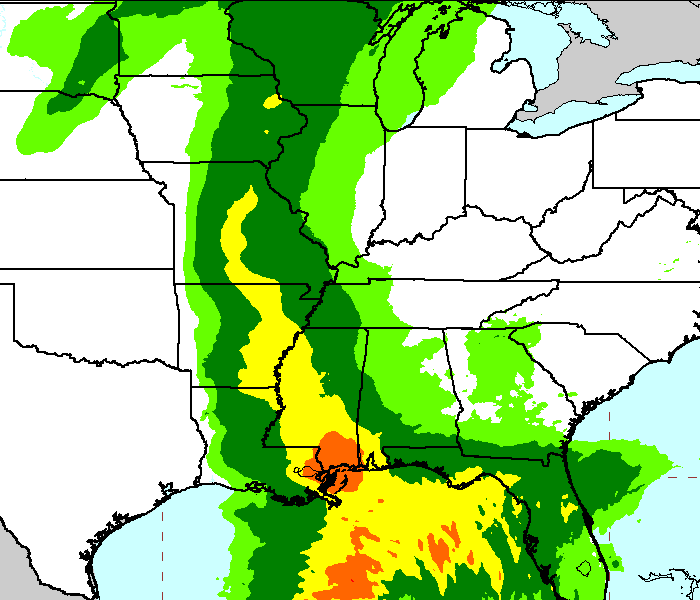 Projected landfall path for Hurricane Cristobal
Projected landfall path for Hurricane Cristobal
Tropical Storm Cristobal
Tropical Storm Cristobal is expected to track into Wisconsin on Tuesday, bringing heavy rains and gusting winds. Only three tropical systems are known to have found their way into Wisconsin, so this is a very unique event. The expected path appears to have Cristobal tracking into the state from southwest to northeast. That could mean areas could get 1 to 2 inches of rain with the possibility of localized flooding. There's also the potential of severe weather on Wednesday, which could mean tornadoes in the area.
SERVPRO of Pewaukee & Sussex has years of experience in mitigating water damages. If your Pewaukee, Wisconsin and surrounding area's home encounters a water damage due to the upcoming storm, please do not hesitate to call us.
SERVPRO of Pewaukee & Sussex 262.696.6336.
Sump Pump Failures in Pewaukee
5/22/2020 (Permalink)
 Sump Pump located in a homeowner's basement
Sump Pump located in a homeowner's basement
Sump Pump Basics
A sump pump is a pump used to remove water that has accumulated in a water-collecting sump basin, commonly found in the basements of homes. The water may enter via the perimeter drains of a basement waterproofing system, funneling into the basin or because of rain or natural ground water, if the basement is below the water table level.
Sump pumps are used where basement flooding happens regularly and to solve dampness where the water table is above the foundation of a home. Sump pumps send water away from a house to any place where it is no longer problematic, such as a municipal storm drain or a dry well.
Why do Sump Pumps fail?
- Sump Pump is having to constantly run
- You have an overworked Sump Pump
- Sump Pump loses power
- Clogged Sump Pump
- Clogged discharge lines
- Your Sump Pump is Defective
- It was installed incorrectly
- Lack of Maintenance
What happens if my Sump Pump fails and causes damage?
If you your sump pump does fail and floods your basement causing water damage, then give us a call! SERVPRO of Pewaukee & Sussex is available 24 hours a day for water emergencies, large or small. 262.696.6336.






 24/7 Emergency Service
24/7 Emergency Service
























